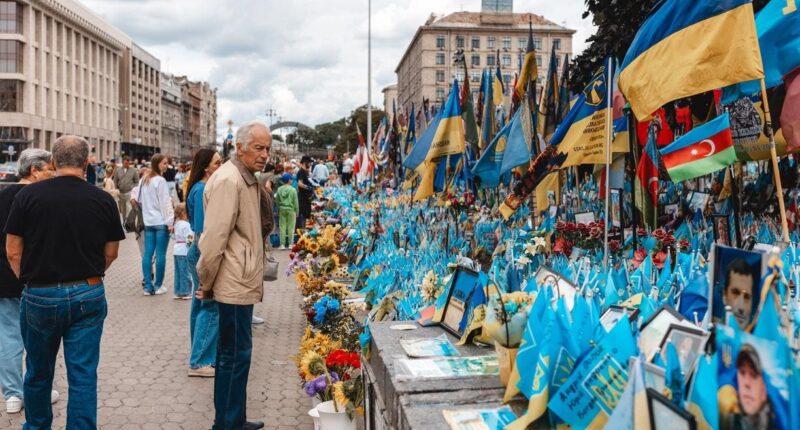Share this @internewscast.com
KYIV, UKRAINE, AUGUST 24, Ukraine’s independence day. Photo by Arsen Dzodzaiev/Anadolu via Getty Images
Anadolu via Getty Images
Dispatches from Ukraine. Day 1,279.
Russian Attacks on Ukraine
Between August 22–25, pervasive Russian attacks killed at least 15 people and maimed more than 90 others across Ukraine. Eastern Kharkiv and Donetsk regions recorded the heaviest toll, with four civilians killed in each province and a total of 26 residents injured. In the central Dnipropetrovsk region, Russian attacks left three residents dead and wounded 15 others. Both southern Kherson and northern Sumy provinces saw at least two civilian deaths and 52 injuries.
Germany and Norway Pledge Billions to Ukraine
During a visit to Kyiv on Aug. 25, Norwegian Prime Minister Jonas Gahr Støre proised to allocate some $7.9 billion in military and humanitarian aid to Ukraine in 2026. Meet with Ukrainian President Volodymyr Zelenskyy and Prime Minister Yulia Svyrydenko, Støre pledged to extend the Nansen Support Programme. “At this critical time for Ukraine, it is important to reaffirm our continued support,” he said, noting that Russia has intensified its missile and drone assaults in recent months.
German Vice-Chancellor Lars Klingbeil also arrived in Kyiv on Aug. 25 on a previously unannounced visit and pledged nearly $10.5 billion in annual support for Ukraine in the coming years. After talks with President Volodymyr Zelenskyy, Klingbeil, who also serves as finance minister, stressed that Moscow must understand that Germany’s commitment will not weaken in the future, framing this assistance as a long-term guarantee of stability, not a temporary measure.
Though its economy is only about one tenth the size of Germany’s, Norway has emerged as one of Ukraine’s most generous supporters. It’s been able to do so in part thanks to record oil and gas revenues, as it has filled a supply gap during the energy crisis triggered by Russia’s 2022 invasion of Ukraine. In 2022 alone, hydrocarbon sales generated roughly $150 billion for its national coffers, nearly triple pre-war levels, providing Norway with unprecedented resources to funnel into aid for Ukraine.
U.S. Blocking Ukrainian Long-Range Strikes on Russia
For months, the Pentagon has blocked Ukraine from using U.S.-made long-range missiles to hit targets deep inside Russia, the Wall Street Journal reported on Aug. 23, citing U.S. officials. A high-level Defense Department approval process has prevented Ukraine from firing any ATACMS, 190-mile range ballistic missiles, against Russian targets since late spring. On at least one occasion, Kyiv requested to use the weapons inside Russia and was denied.
The Pentagon’s review procedure also manages other weapons transfers. Pentagon policy chief Elbridge Colby has categorized munitions into green, yellow, and red tiers, limiting what can be sent to Kyiv based on U.S. stockpiles. Defense Secretary Pete Hegseth now has the authority to reclaim weapons in short supply.
The move likely reflects the White House’s effort to push Moscow toward peace talks. “President Trump has been very clear that the war in Ukraine needs to end,” said White House press secretary Karoline Leavitt. “There has been no change in military posture in Russia-Ukraine at this time,” she continued. A senior official added that the review mechanism developed under Colby gives Hegseth the final say on any long-range strike.
The restrictions reverse a decision by the Biden administration in its final year to allow Ukraine to use long-range U.S.-made weapons to target Russia. While ATACMS and other long-range weapons, including Britain’s Storm Shadow cruise missile, haven’t impacted the war in any considerable manner, they have allowed Ukraine to threaten Russian command centers and airfields far from the front lines.
Facing U.S. restrictions, Ukraine has sought its own alternatives. The country has deployed drones against Russian refineries and aircraft and is reportedly developing a new cruise missile, the Flamingo, which President Zelenskyy said could be produced in significant quantities by early next year.
Meanwhile, the U.S. recently approved the sale of 3,350 Extended Range Attack Munition (ERAM) air-launched missiles, which will arrive in Ukraine in about six weeks. Essentially, the weapon represents a hybrid between an air-dropped bomb and a cruise missile, with an operational range of up to 285 miles, and is guided for precision strikes. It can be deployed from various aircraft and may be adapted for future naval or drone-targeting roles. But these advanced munitions would require Pentagon approval before use for strikes deep inside Russian territory.
According to President Zelenskyy, Kyiv is currently self-reliant in terms of conducting long-range strikes against Russia. “At the moment, we are using our long-range domestically produced weapons, and we haven’t been discussing such matters with the U.S. lately,” he told reporters at a press conference on Aug. 24, when Ukraine celebrated the 34th anniversary of its Independence from the Soviet Union.
POWs Swap
On Aug. 24, Ukraine’s Independence Day, Kyiv announced another prisoner exchange with Russia, which brought home a group of 146 soldiers and civilians held since 2022. Among those released was Volodymyr Mykolaienko, former mayor of Kherson, a southern regional capital that came under Russian occupation in March of 2022 and was liberated that November. Mykolaienko had refused to collaborate with the occupational authorities and was, therefore, deported to Russia. Moscow said it repatriated 146 Russian POWs on the same day.
Culture Front: Art, Culture, and Resilience Mark Independence Celebrations
In New York, various cultural events took place to celebrate Ukraine’s 34th renewed independence. The Ukrainian Institute of America had a family-friendly Open House featuring traditional Ukrainian cuisine, contemporary design pop-ups, a pysanky exhibit of easter eggs decorated using traditional batik dyeing, film screenings and a special exhibition showcasing rare authentic 19th- and early 20th-century traditional costumes.
Also in New York, the Liberty Ukraine Foundation hosted a charity evening at the Ukrainian National Home in the East Village, featuring jazz performances, vocalists, the Ukrainian Chorus Dumka, and contemporary dance. The event raised funds for the purchase of drones for Ukrainian defenders.
The 2024 documentary “Checkpoint Zoo,” directed by Joshua Zeman and supported by Leonardo DiCaprio’s Appian Way Productions, is now playing in select U.S. theaters. The poignant film follows the evacuation of five thousand animals, including lions, cheetahs, kangaroos, and llamas, from Kharkiv’s eco park, by a group of brave animal-lovers in the early days of Russia’s invasion.
Black Cloud, an installation by Ukrainian artist Oleksiy Sai and his team at Burning Man, was destroyed by a dust storm during the first day of the gathering.
Gregory Veoryk
The massive Ukrainian art installation “Black Cloud” made a big, albeit short-lived, impression at this year’s Burning Man festival in Nevada’s Black Rock Desert. Nearly 100 feet long, 56 feet wide and 50 feet in height, Ukraine’s monumental, interactive art installation in the shape of a giant storm cloud, was designed to symbolize the looming threat of global conflict and featured a soundscape of real war sounds from Ukraine. But it was destroyed in a violent dust storm that kicked up on Aug. 24, the festival’s opening day and Ukraine’s Independence Day. Despite withstanding only fifteen minutes of near hurricane-force winds, “Black Cloud” will be rebuilt and is slated for a European tour.
Worldwide, Ukraine’s Independence Day was marked by hundreds of events. Canada held more than 30 gatherings, Australia staged multi-state celebrations, including the unveiling of the world’s largest Ukrainian flag in Sydney, and European cities hosted large marches. Stockholm’s event drew prominent political figures; Lisbon saw more than 500 participants; Washington, D.C. featured prayers and marches near the White House, and Warsaw’s central square attracted roughly 30,000 attendees, underscoring global support for Ukraine’s sovereignty and democratic values.
In Kyiv, the PinchukArtCentre, in partnership with Ukrainian Railways, unveiled a new painting, “Motion,” by Lesia Khomenko at Kyiv’s Central Railway Station on Aug. 24. The massive 69×40-meter painting, depicting travelers from all walks of Ukrainian society, hangs in the arrivals hall at Kyiv’s main train station, symbolizing the collective strength and forward momentum of the Ukrainian people amid the ongoing conflict. A solo exhibition by Khomenko opens at the PinchukArtCentre on August 28.
By Danylo Nosov, Karina L. Tahiliani





